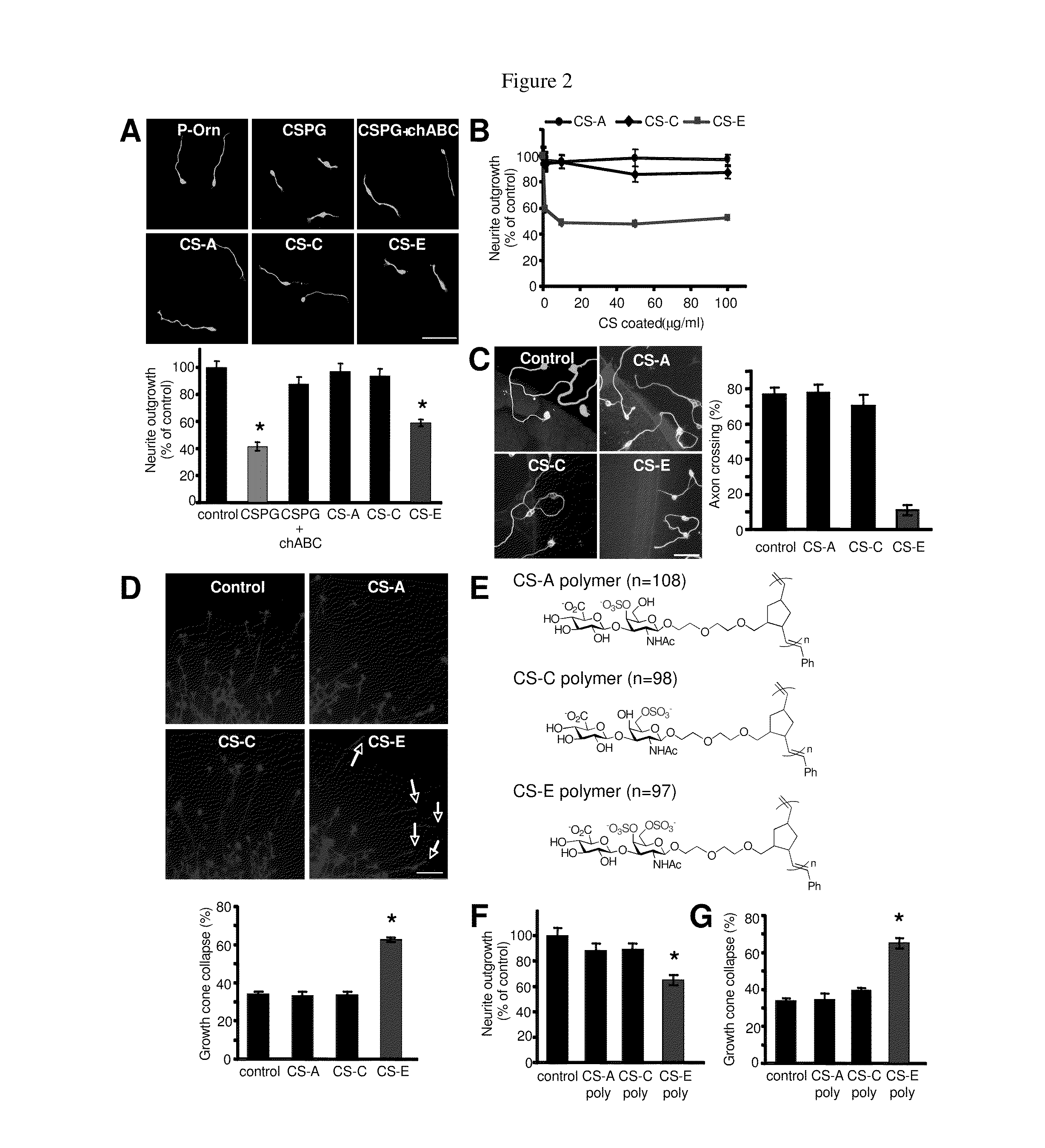Methods and compositions for treating neuronal damage or degeneration
a neuronal damage and composition technology, applied in the field of neuronal damage or degeneration, can solve the problems of no effective treatment for regenerating or repairing damaged nerves, nerve damage or degeneration, damage or degeneration, etc., to promote or improve locomotor function, improve locomotor function, grasp the effect of bladder function
- Summary
- Abstract
- Description
- Claims
- Application Information
AI Technical Summary
Benefits of technology
Problems solved by technology
Method used
Image
Examples
example 1
Dorsal Root Ganglion (DRG) Neurite Outgrowth Assay
[0137]Neurite outgrowth assays using dorsal root ganglions are useful for assaying the effects of the methods and compositions of the present invention in promoting neuronal regeneration or neurite outgrowth or in reducing or eliminating CS-E mediated signaling such as for example CS-E mediated inhibition of neuronal growth. Acid-treated, 15-mm round German glass coverslips (Carolina Biologicals) are coated with poly-DL-ornithine (P-Orn; Sigma-Aldrich) in pH 6.5-8.5 borate buffer (approximately 0.5 mg / ml) for about 2 hr at about 37 ° C. and approximately 5% CO2. The coverslips are then washed with sterile water and dried in air. CSPGs (approximately 1 μg / ml; Chemicon), CSPGs treated with chondroitinase ABC (Seikagaku; 1-40 mU ChABC per pg CSPG incubated for about 2 hr at approximatley 37° C.; complete cleavage verified by SDS-PAGE), polysaccharides enriched in the CS-A, CS-C or CS-E sulfation motifs (approximately 1 μg / ml based on gl...
example 2
Growth Cone Collapse Assay
[0138]Growth cone collapse assays are useful for assaying the effects of the methods and compositions of the present invention in promoting neuronal regeneration or neurite outgrowth or in reducing or eliminating CS-E mediated signaling such as for example CS-E mediated inhibition of neuronal growth. 8-Well Lab-Tek® II CC2™ Slides (Electron Microscopy Sciences) are coated with P-Orn in pH 6.5-8.5 borate buffer for about 2 hr at 37° C. and 5% CO2, then coated with laminin (approximately 10 μg / ml; Invitrogen) for about 2 hr at 37° C. and 5% CO2. DRG explants are dissected from E6-10 chick embryos and grown on the P-Orn / laminin substratum for about 24 hr, treated with the indicated polysaccharides (at approximately 10 μg / ml) or glycopolymers (at approximately 10 μg / ml) for about 30 min, fixed in PFA with 5-15% sucrose, stained using rhodamine phalloidin (Pierce), and imaged using a Nikon TE2000-S fluorescent microscope. The percentage of collapsed growth cones...
example 3
[0139]Boundary crossing assays are useful for assaying the effects of the methods and compositions of the present invention in promoting neuronal regeneration or neurite outgrowth or in reducing or eliminating CS-E mediated signaling such as for example CS-E mediated inhibition of neuronal growth. CS polysaccharides at various concentrations mixed with Texas Red (at approximately 0.5 mg / ml; Invitrogen) are spotted at the center of P-Orn-coated coverslips (about 5 μl) for about 2 hr at 37° C. and 5% CO2. Cerebella are dissected from P5-9 Sprague Dawley rats, incubated in 0.0125%-0.25% trypsin w / EDTA for about 15 min at 37° C., triturated to dissociate to single cell suspensions, purified on a discontinuous Percoll gradient, and cultured on the coated coverslips for about 48 hr. Cells are fixed in PFA with 5-15% sucrose, immunostained using an anti-β tubulin III antibody, imaged using a Nikon TE2000-S fluorescent microscope and Metamorph software, and quantifie...
PUM
| Property | Measurement | Unit |
|---|---|---|
| radius | aaaaa | aaaaa |
| concentrations | aaaaa | aaaaa |
| time | aaaaa | aaaaa |
Abstract
Description
Claims
Application Information
 Login to View More
Login to View More - R&D
- Intellectual Property
- Life Sciences
- Materials
- Tech Scout
- Unparalleled Data Quality
- Higher Quality Content
- 60% Fewer Hallucinations
Browse by: Latest US Patents, China's latest patents, Technical Efficacy Thesaurus, Application Domain, Technology Topic, Popular Technical Reports.
© 2025 PatSnap. All rights reserved.Legal|Privacy policy|Modern Slavery Act Transparency Statement|Sitemap|About US| Contact US: help@patsnap.com



